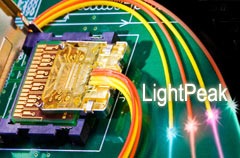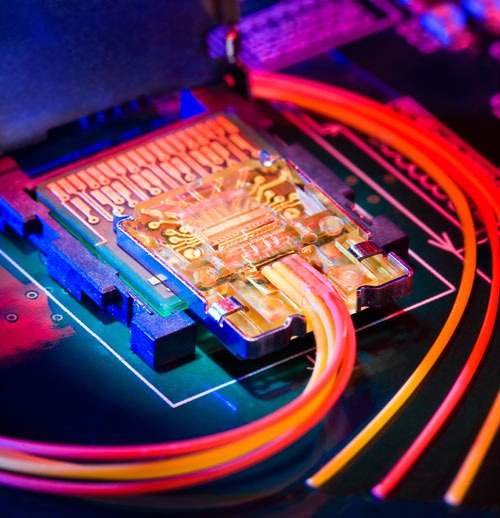 Light Peak is the future of connectivity whether its display, data or any other mode of communications, LightPeak delivers fastest data transfers we’ve seen so far on the computers.
Light Peak is the future of connectivity whether its display, data or any other mode of communications, LightPeak delivers fastest data transfers we’ve seen so far on the computers.
If you know about HDMI, USB 3.0, you might actually feel the inferiority of those technologies, as LightPeak takes over.
LightPeak is Intel proprietary Optical cable interface to connect peripheral bus giving throughputs upto 10Gigabit/s and have a potential of extending to 100Gb/s over a period of next few years. At 10Gb/s, you could transfer a full-length Blu-Ray movie in less than 30 seconds. Optical technology also allows for smaller connectors and longer, thinner, and more flexible cables than currently possible. Light Peak also has the ability to run multiple protocols simultaneously over a single cable, enabling the technology to connect devices such as peripherals, displays, disk drives, docking stations, and more.
A typical computer system involves a large number of interfaces namely SATA, SCSI, USB, Firewire, PCI Express – each one dedicated to its scope with limited bandwidth capabilities. LightPeak would clear of this mess by providing one unified interface to connect almost anything – whether it’s a Display panel/Monitor or a external/internal harddrive, they all work on LightPeak, and they work much faster than before.
Apart from unifying communications, it would make interfaces cheaper Light Peak, unlike most fiber ICs, was designed to be lithographically created directly on a CMOS IC, which can reduce size and manufacturing costs. However, the LightPeak will not replace existing HDMI, DisplayPort technologies immediately, it would be gradual.
The Light Peak cable contains a pair of optical fibers (each 62.5 micron wide) that are used for upstream and downstream traffic. This means that Light Peak offers a maximum of 10 Gbit/s in each direction at the same time i.e. 10Gbps Full duplex. The maximum length of the cable can run upto 100meters, requiring repeaters beyond that.
Since LightPeak cables has decent max length, they have also been looked as 10Gigabit Ethernet killers. 10Gigabit ethernet is way more costly, but its hard to actually transition all future networks to a new physical layer.
Apple’s Thunderbolt Technology
Apple is doing a rebranding for the LightPeak technology to Thunderbolt High Speed I/O. The rumor gears are really starting to churn with regard Apple’s upcoming MacBook Pro refresh and now we have a purported leak of the upcoming spec sheet for the new 13-inch model. The Thunderbolt port would look much like the Mini DisplayPort but has a tidy little lightning logo next to it.
Update: Apple has announced new MacBook Pros with Thunderbolt technology.
“The new MacBook Pro brings next generation dual and quad Core processors, high performance graphics, Thunderbolt technology and FaceTime HD to the great design loved by our pro customers,” said Philip Schiller, Apple’s senior vice president of Worldwide Product Marketing. “Thunderbolt is a revolutionary new I/O technology that delivers an amazing 10 gigabits per second and can support every important I/O standard which is ideal for the new MacBook Pro.”
Imagine accessing multiple streams of uncompressed HD video — from your notebook — at speeds that let you edit an HD feature film in real time. That’s how Thunderbolt technology will connect the next generation of high-performance peripherals to the next generation of computers — starting with MacBook Pro. Ultrafast and ultraflexible, the Thunderbolt pipeline is more than 12 times faster than FireWire 800 and up to 20 times faster than USB 2.0, and it offers unprecedented expansion capabilities. It changes what you can do on a notebook.
The Thunderbolt port will give you plug-and-play performance with a whole new world of Thunderbolt peripherals, as well as with the Apple LED Cinema Display and other Mini DisplayPort peripherals. You can daisy-chain as many as six devices, including your display. And with support for video and eight-channel audio, it’s easy to connect HDMI-compatible devices — like your TV and home stereo — using the HDMI adapter you already have. Current VGA, DVI, and DisplayPort adapters are also supported.
For latest Hardware, iPhone, android, Tech news @taranfx on Twitter and Facebook Fanpage you can also subscribe to use below:
loading...
loading...






